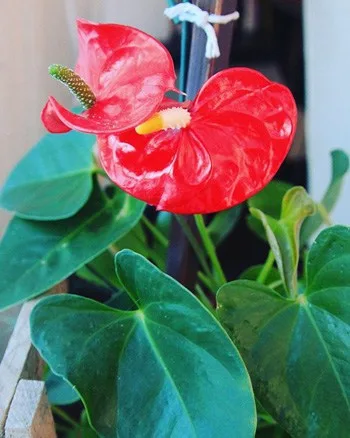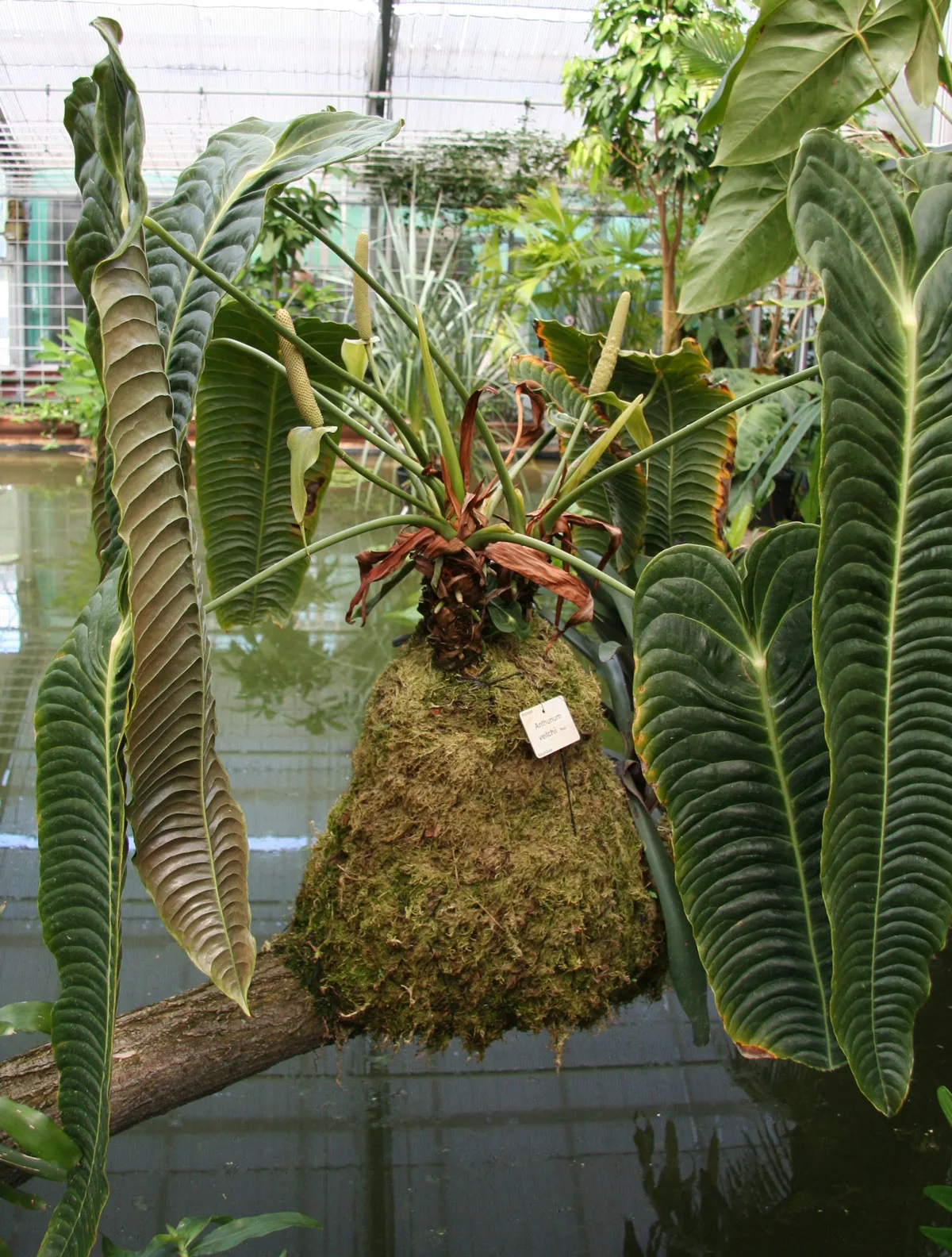Some of the links in this post may be affiliate links.
There are many varieties of Anthurium, but this post will focus on growing the “plain” old Anthurium that you see being sold everywhere. There are a few common names for this plant including flamingo flower, flamingo plant and painter’s palette. I will teach you everything I have learned about anthurium care throughout the years.

If you know me, you know how much I don’t like common names! So I’ll just stick with Anthurium which is the genus.
You may be surprised how big they can get. I didn’t know they grew this way until mine started vining.
I’ve had the plant for well over a dozen years and it keeps getting bigger and bigger! Be sure to give your Anthurium a small trellis or a stake for support if/when it starts to extend, just like mine in the photo above.
There are only two species of Anthurium that have red flowers and they are Anthurium andraeanum and Anthurium scherzerianum.
Actually the red “flower” is the spathe of the plant. The spathe is actually a modified leaf.
Anthuriums belong to the Aroid plant family and they typically have a spathe and a spadix. In nature the spathe is used to attract pollinators to the tiny flowers which are found on the protruding spike called a spadix.
Notice the red spathe on my Anthurium below, and the green and white spadix. On fresh flowers, the spadix will be white, and then it turns green as it ages.

I suspect that most of the commonly available anthuriums are either the Anthurium andreanum species, or perhaps a cultivar of this species or a hybrid.
Table of Contents
Anthurium Plant Care
Anthurium Benefits
There are a number of benefits of growing Anthurium. Some of my favorite parts about this plant are the following.
The waxy red flowers last seemingly forever! Ok well not forever, and I’ve never timed the lifespan of a single flower, but they will easily last several weeks if not longer.
As your anthurium gets older like mine, if you give it the proper care, it will be in perpetual bloom. I am not exaggerating when I say that mine has been in constant bloom now for years, even in the winter.
Anthurium was listed in NASA’s clean air study for its ability to remove a variety of indoor air toxins.
Although I didn’t include Anthurium in my blog post of easiest to grow plants to clean your indoor air, this plant is worth growing! Keep reading about how I take care of mine and you can be successful too!

Anthurium Cons
Anthuriums are not the easiest plants to grow indoors and never make any “top 10 easy plants to grow” lists. However, if you follow my care advice that I will give shortly in this post, you will find that they CAN be easy to grow with some knowledge and consistency in care!
Anthuriums are also mildly toxic to cats and dogs, but the reaction is rarely severe. Read about the details in this Anthurium toxicity post.
Anthuriums love higher humidity, and some Anthuriums are more suited to indoor culture than others, but you can still manage to grow them indoors. I have managed to keep mine alive for over a decade and it is still thriving.
Now let’s talk about Anthurium cultivation! I know this is what you’ve been waiting for!
Anthurium Light
Anthuriums like mostly bright indirect light. Some direct sun, especially morning sun, is beneficial for flowering to occur.
My anthurium lives in front of an Eastern facing window and flourishes. Be careful not to give it too much direct sun though. These plants simply can’t take full sun.
On the other hand, if you expect them to flower, they must be right in front of a window. Always situate your anthurium directly in front of a window for best results.
These plants come from the South American rainforest and many species are epiphytes. Too much direct sun can harm these plants. Supposedly if the edges of the leaves are bleached, it could be due to too much direct sun.
It’s all about a balance. Experiment until you have enough light for flowering, but not too much light that will harm the leaves.
Watering Anthurium
Anthuriums will not tolerate neglect when it comes to water. If you frequently are forgetful about watering, you may want to pick another plant to grow!
Never let your Anthurium dry out completely. If you do, your leaves will yellow and dry up one by one until nothing is left.
These are rainforest plants and they are used to water everyday in nature. However, they must NOT ever sit in water for extended periods of time.
Many Anthurium are epiphytes, meaning they grow on other plants such as trees, so they demand excellent drainage.

Anthurium Potting Mix
The beauty about growing plants is that they can grow in a variety of potting mediums. There is no ONE perfect potting mix for Anthuriums.
What you want to achieve in an Anthurium potting mix is to aim for a nice, loose, airy mix that drains well.
But you want to keep the potting media on the moister end.
I had my Anthurium pictured in this blog post growing in a terra cotta pot with plain potting soil. I don’t even remember what I used because the plant is many years old.
When I repotted it, I mixed in some orchid bark and perlite into an all-purpose potting soil. The result was a super well draining potting mix.
Just keep in mind though that with a chunkier potting mix with sharp drainage, it will dry out more quickly so it will require watering more frequently! The best mix you can provide will be moist, but chunky and airy.
With such a loose, chunky and sharply draining potting mix, it becomes difficult to “overwater.”
I was reading on one website that said that you could water your Anthurium everyday if you have this type of potting mix. I do think this may be excessive, but you get the point.
Never, ever let your Anthurium get bone dry. But do keep it on the moister end. I would aim to water every time the surface feels dry. This would be an ideal case to shoot for in watering your Anthurium.
Anthurium Fertilizer
I fertilize my Anthurium like I do pretty much all of my houseplants. Weakly with every watering.
I have used a variety of fertilizers over the years for houseplants, and I have simplified things greatly.
I now use Dyna-Gro Grow fertilizer for most of my houseplants.
This is a very high quality, urea-free fertilizer and that is a complete formulation. I use this now for all my leafy tropicals.
It is great because it is also very effective for foliar feeding as well as hydroponic gardening. It’s a great one-stop shop fertilizer for general usage!
Anthurium Humidity
Since these plants come from rainforests, you can image the humidity that they enjoy in their native environments.
My own plant has been growing in normal indoor conditions for all these years, but if you can provide more humidity, your plant will love you even more.
Check out my humidity blog post for more details on how you can effectively increase humidity for your plants. I also talk about my FAVORITE humidifier in that post and I’ve tested many!
In the summer, I started placing my Anthurium outdoors. It is really the best thing you can do for your plants. Just be sure to harden off your houseplants if you place them outdoors to make sure they don’t burn.
Anthurium Propagation
There are a couple easy ways to propagate Anthuriums.
One is to simply divide your Anthurium at the roots if there are multiple vines in the same pot.
The other way is to take cuttings. Take a look at the photo below.

With this method, you’d have to wait until your plant is old enough to actually take cuttings. Notice the aerial roots on the vine. There are several along the vine.
You can simply take a cutting and ensure that the cutting has at least one or two aerial roots. Then place the cutting in water to root a bit, and you can then plant it in an Anthurium-friendly potting mix. Easy!
Once you have mastered growing this type of Anthurium, you can explore some of the less common Anthuriums that are grown mainly for their foliage.
Do you have any Anthuriums? Comment below! I’d love to hear from you.







Gai
Sunday 9th of June 2024
Oh dear I think I over water my new pink anthurium plant. Now yellowing n floppy leaves. I have remove sick looking leaves, took the pot out of decorative pot n put it in the sun to dry. Should I dig it out n out, wash off all soil n repot again? But then still need to water in the new soil. Please help thanks.
Raffaele Di Lallo
Tuesday 11th of June 2024
Are you sure you "overwatered"? Was it the bottom leaves that yellowed? Usually this is an indication that the soil went much too dry. Did the soil go really dry and then you watered? Did the floppy leaves recover at all after watering? Why do you think you overwatered? I ask because most or the time, people think they "overwatered", when in fact, it's the opposite.
Eliza
Monday 12th of February 2024
Thanks for you clear information on the management of my Anthurium. I have had my plant next to eastern light for 4 years it took a year to start flowering and has not stopped yet. I am very happy with this ☺ coulorful plant.
Raffaele Di Lallo
Monday 12th of February 2024
Glad you enjoyed this post Eliza!
Robin U
Wednesday 2nd of August 2023
I learned a lot about anthuriums. I live in a very humid state— Central Florida so my new little plant should be happy!!
Raffaele
Wednesday 2nd of August 2023
Yes, your plant should definitely be happy!
Mary Nichols
Tuesday 30th of May 2023
This is Mary I too are having a issue with my plant Arthurian we bout it with the Leaves having brown spots do I cut the leaves off and where do I cut them or leave them on?
Raffaele
Wednesday 31st of May 2023
If it's just one or two leaves, you can cut them off and throw them away. If you have a lot of leaves with brown spots, it might be a fungal issue. You can try spraying with a fungicide.
Helen
Thursday 20th of April 2023
Hi. Thanks for the article. So helpful. I'm having an issue with my Anthurium It hasn't flowered in over a month and the leaves are going yellow. It also has some brown spots along the edges of the leaves. These appear before it yellows. I'm wanting to repot in the soil you suggested. But could these spots be something nasty I need to treat first. I don't want to lose my plant. Trying to save her. Thankyou so much..
Raffaele
Friday 21st of April 2023
Hi Helen! I'd have to see a photo of the plant. Can you use the contact form on my site to email me, and when I reply, you can attach photos and we can go from there!